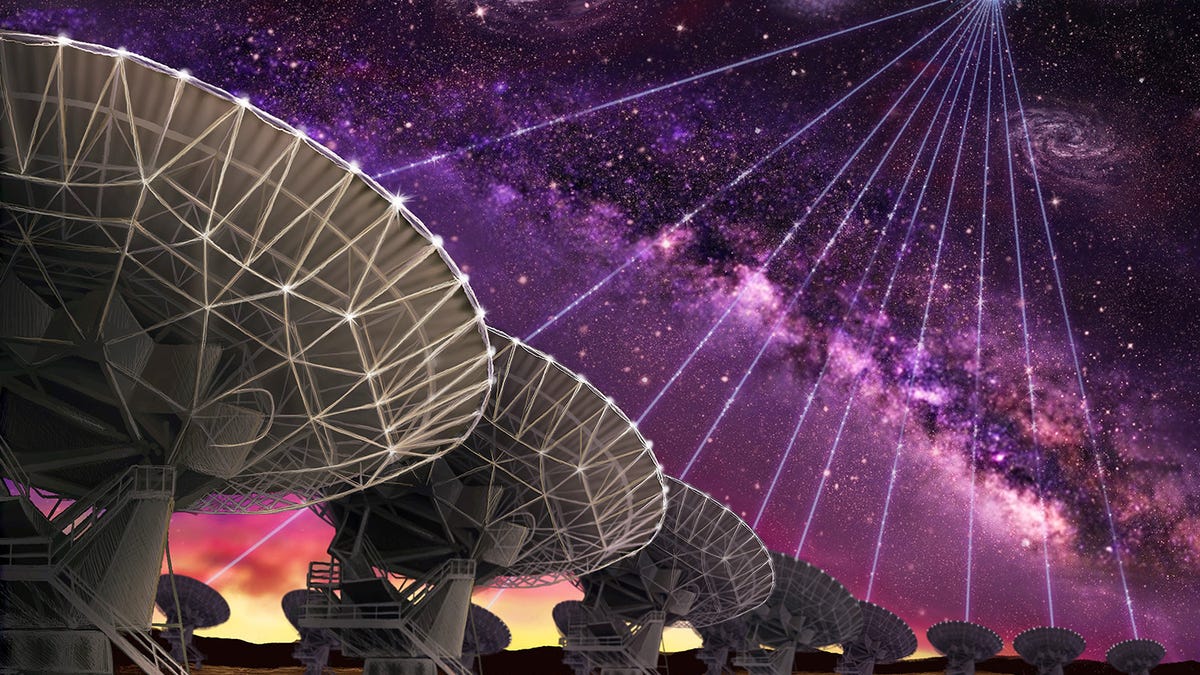Mysterious signal from deep space goes hyperactive
Scientists searching the cosmos for signs of intelligent alien life pick up the only known repeating "fast radio bursts" again and are asking others to tune in too.

FRB 121102 originates from a distant dwarf galaxy
The unexplained signals from the other side of the universe known as fast radio bursts are a rarely observed phenomenon and only one of them has been picked up more than once. Now scientists engaged in the search for extraterrestrial intelligence say that lone repeating fast radio burst (FRB) is being heard twittering away.
FRBs are bright, millisecond-long pulses of radio signals from beyond the Milky Way that were first identified only a decade ago. Suggested explanations include everything from neutron star outbursts to alien civilizations using some form of directed energy to propel a spacecraft.
One burst first observed in 2012, named FRB 121102, was later found to repeat in 2015. On Saturday, UC Berkeley postdoctoral researcher Dr. Vishal Gajjar used the Breakthrough Listen backend instrument at the Green Bank Telescope in West Virginia to target FRB 121102 once again. After observing for five hours and across the entire 4 to 8 GHz frequency band, Gajjar and the Listen team analyzed the 400 terabytes of data gathered and found 15 new pulses from FRB 121102.
"The possible implications are two folds," Gajjar told me via email Tuesday. "This detection at such a high frequency helps us scrutinize many (of FRB 121102's) origin models. The frequency structure we see across our total band of 4 to 8 GHz also allows us to understand the intervening medium between us and the source."
The location of FRB 121102 has already been previously traced to a dwarf galaxy about 3 billion light years away, but what exactly might be sending out such strong signals from there remains a mystery. Gajjar says that the repeating nature and current state of heightened activity for FRB 121102 does seem to rule out some of the most destructive explanations, such as colliding black holes.
"As the source is going into another active state means that the origin models associated with some sort of cataclysmic events are less likely to be the case of FRB 121102," he said. "It should be noted that they can still be valid for other FRBs."
Whatever or whoever sent out the bright radio bursts, they left their source a very long time ago when the only life here on Earth was single-celled. Perhaps some ancient intelligent species was clued in to the emergence of life on our planet and knew that a signal sent would reach us just as we were becoming technologically sophisticated for the first time?
Perhaps, but given the current lack of evidence of such extra-terrestrial life, a natural phenomenon like a pulsar seems a more likely explanation.
The Breakthrough Listen team urged other astronomers to make follow-up observations of FRB 121102 during its current state of heightened activity in an Astronomer's Telegram post that first reported the new results on Monday. The researchers say the new bursts will be described in more detail in an upcoming paper for a scientific journal.
The streaks across the colored energy plot are fast radio bursts, or FRBs, appear at different times and different energies because of dispersion caused by 3 billion years of travel through intergalactic space.
Technically Literate: Original works of short fiction with unique perspectives on tech, exclusively on CNET.
Crowd Control: A crowdsourced science fiction novel written by CNET readers.

